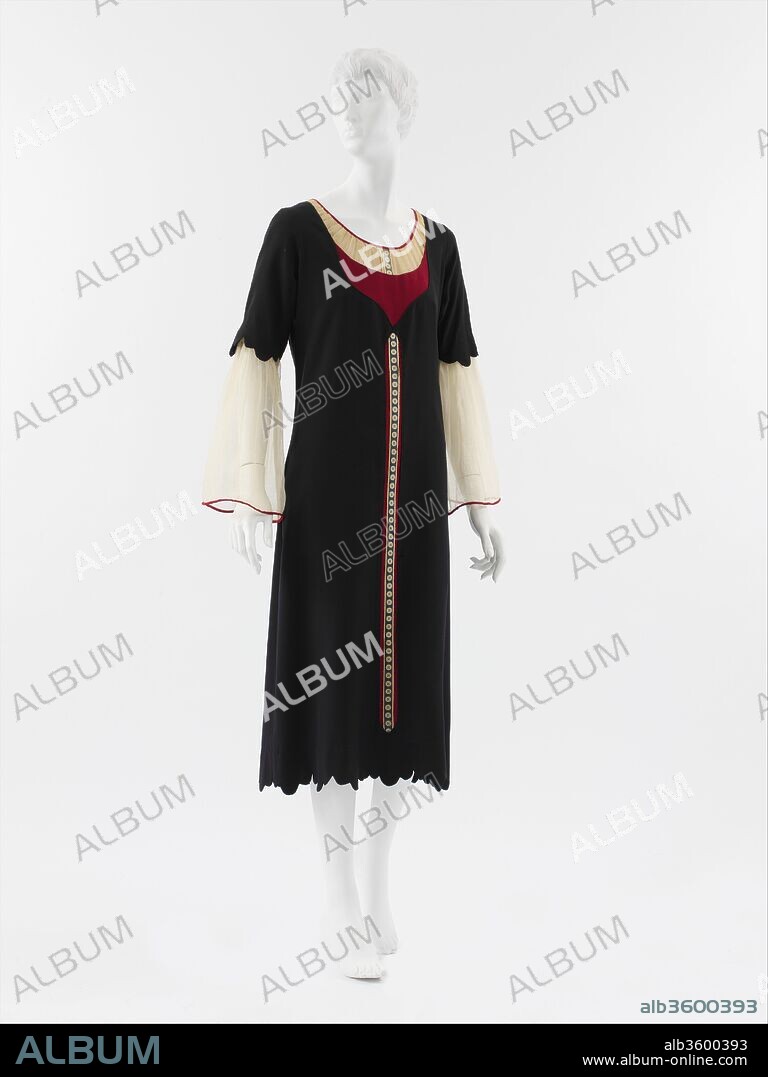alb3600393
PAUL POIRET. DRESS

|
Ajouter à une autre Lightbox |
|
Ajouter à une autre Lightbox |



Avez-vous déjà un compte? S'identifier
Vous n'avez pas de compte ? S'inscrire
Acheter cette image

Auteur:
Titre:
DRESS
Légende:
Traduction automatique: Robe. Culture : français. Designer : Paul Poiret (français, Paris 1879-1944 Paris). Date : 1925. En raison de leurs couleurs audacieuses, de leurs riches détails, de leurs silhouettes dramatiques (si simples) et de leurs références immédiatement reconnaissables, les créations de Poiret à la mode orientaliste en sont venues à représenter l'identité la plus forte de sa maison. En fait, les collections de Poiret étaient un amalgame de tous ses intérêts. Plutôt qu'un thème unifié, ses présentations offraient aux clients une gamme de silhouettes et d'effets stylistiques. De nombreux modèles citent les vêtements pour hommes, les vêtements de sport (ce que Poiret finira par rejeter comme un style inapproprié pour la haute couture) et les styles historiques, en particulier ceux de l'Antiquité, du Moyen Âge, de la Renaissance et du Second Empire, dans un mélange éclectique enivrant. Bien que « Bouclier » semble exclure une autre période ou culture qui aurait pu être son inspiration, l'historicisme informé de Poiret se révèle dans le détail en trompe-l'?il d'une patte étroite imprimée d'un motif de bouton, qui fait référence aux robes chasubles boutonnées des années 1880. . L'effet est l'illusion d'un chemisier ou d'une chemise en coton transparent sous une robe rouge avec une sur-robe bleu marine. Alors que ses caractéristiques de conception sont principalement frontales, Poiret a ajouté un n?ud décoratif à l'encolure dos, renforçant son esprit ludique. Par sa palette de couleurs et son association avec le style chic des jeunes Parisiennes, la robe fait allusion à l'identité nationale française. Il était représenté dans Art-Goût-Beauté avec un autre modèle appelé "École", également rendu en bleu, blanc et rouge. Les deux robes étaient associées à des accessoires assortis pour souligner leurs connotations nationalistes. Poiret était un patriote féroce bien qu'il ait été critiqué pendant la Première Guerre mondiale pour son goût boche à cause d'un dessin animé dans le journal de bande dessinée allemand Simplicissimus qui présentait une femme au foyer allemande assurée par son mari soldat qu'elle obtiendrait bientôt une nouvelle robe Poiret. En effet, pour Poiret, orientalisme et classicisme, souvent considérés comme des modèles esthétiques rivaux dans le discours du modernisme, se renforçaient mutuellement comme expressions de son patriotisme, tant ils étaient profondément enracinés dans la politique culturelle de la France.
Dress. Culture: French. Designer: Paul Poiret (French, Paris 1879-1944 Paris). Date: 1925.
Because of their bold coloring, rich detailing, dramatic (if simple) silhouettes, and immediately recognizable references, designs by Poiret in the orientalist mode came to represent the strongest identity of his house. In fact, Poiret's collections were an amalgamation of all his interests. Rather than one unified theme, his presentations offered clients a range of silhouettes and stylistic effects. Many designs cited menswear, sportswear (something Poiret would eventually repudiate as an inappropriate style for the haute couture), and historical styles, especially those from antiquity, the Middle Ages, the Renaissance, and the Second Empire, in a heady eclectic mix.
Although 'Bouclier' appears to preclude another period or culture that might have been its inspiration, Poiret's informed historicism reveals itself in the trompe l'oeil detail of narrow placket printed with a button motif, which references the button-down pinafore dresses of the 1880s. The effect is of an illusion of a sheer cotton blouse or chemise under a red dress with a navy overdress. While its design features are primarily frontal, Poiret added a decorative bow to the back neckline, reinforcing its playful spirit.
Through its color palette and its association with the chic style of young Parisiennes, the dress alludes to French national identity. It was represented in Art-Goût-Beauté with another model called 'École,' also rendered in blue, white, and red. Both dresses were paired with matching accessories to underscore their nationalistic overtones. Poiret was a fierce patriot despite having been criticized during World War I for his boche taste because of a cartoon in the German comic paper Simplicissimus that featured a German housewife being assured by her soldier husband that she would soon get a new Poiret dress. Indeed, for Poiret, orientalism and classicism, often seen as rival aesthetic models in the discourse of modernism, were mutually reinforcing expressions of his patriotism, so deep-rooted were they in the cultural politics of France.
Technique/matériel:
wool, silk
Musée:
Metropolitan Museum of Art, New York, USA
Crédit:
Album / Metropolitan Museum of Art, NY
Autorisations:
Modèle: Non - Propriété: Non
Questions sur les droits?
Questions sur les droits?
Taille de l'image:
3170 x 4226 px | 38.3 MB
Taille d'impression:
26.8 x 35.8 cm | 10.6 x 14.1 in (300 dpi)
Mots clés:
 Pinterest
Pinterest Twitter
Twitter Facebook
Facebook Copier le lien
Copier le lien Email
Email
